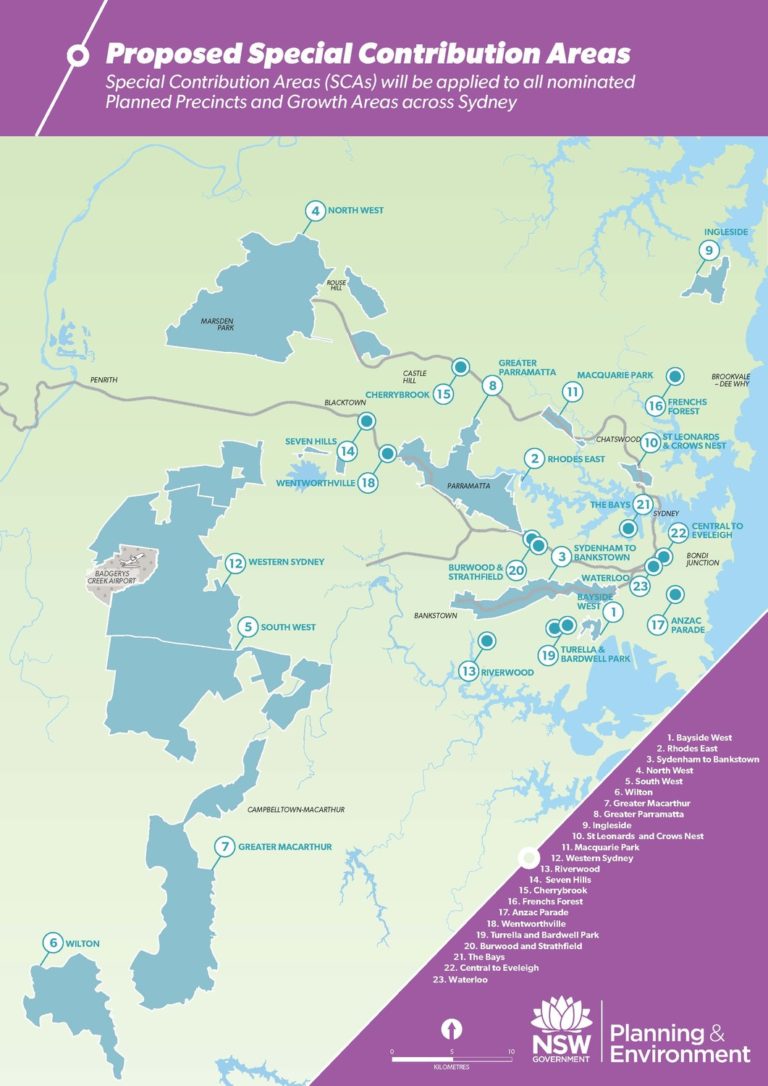5 reasons why there should be comprehensive infrastructure plans for Sydney’s Planned Precincts
2 December 2017

The NSW Department of Planning & Environment proposes to implement 23 Special Infrastructure Contributions (SICs) across Sydney’s Planned Precincts.
According to the Department’s website these SICs will fund State and regional roads, transport facilities such as bus shelters and interchanges, regional open space, pedestrian links and cycleways, and social infrastructure such as schools, healthcare and emergency services.
A lot of time has been spent by the Department to determine contributions that are reasonable and affordable. But that is only for State infrastructure. What about the local infrastructure? Contributions for local infrastructure such as sub-arterial and collector roads, stormwater drainage, local and district parks and libraries and community centres will be left to the councils to sort out through the separate preparation of section 94 plans.
There is clearly an opportunity for a more coordinated and comprehensive approach, but this opportunity is being missed.
There should be a comprehensive infrastructure funding and delivery plan for each Planned Precinct. The plan should be underpinned by an agreed funding mix, with the respective roles / shares to be provided by contributions, value sharing/betterment, special rates, grants, other taxes and charges.

Here are 5 reasons why this makes sense:
1. The legislation enables it.
Section 94EE (3A) of the Environmental Planning & Assessment Act allows the Minister for Planning to determine a SIC that, in addition to addressing infrastructure provided by the State, can also include a contribution amount ‘for the provision of infrastructure by a council’. S94EE (3B) (c) further provides that the council portion of a SIC is ‘to be provided to the council and is to be held and applied by the council in accordance with section 93E’. S93E says that the council may pool the funds it receives, and that the infrastructure must be provided in a reasonable time.
2. Developers and the community expect it.
The public does not care who is responsible for regional parks and who is responsible for local sports fields. But they do expect that the right infrastructure will be provided in the right place at the right time. This is where both State and local government has fallen behind. We need to get smarter about infrastructure planning and delivery. This is done by collaboration, coordination, making timely decisions that send the right pricing signals to developers, and having a clear path for implementation. Consolidated progress reporting on the infrastructure roll-out for each precinct will provide the minimum levels of transparency and accountability. None of this can be achieved through following a business-as-usual approach.
3. A comprehensive approach is efficient and cost-effective.
A well-researched nexus-based contributions plan takes time. A joint approach and pooling of resources between councils and the Department would lead to earlier identification of the full infrastructure requirements and contributions for development precinct. The Department and the councils can clearly learn from each other in terms of understanding the impacts on development feasibility and in setting up consistent policies and practices for such things as timing of payments and works in kind agreements.
4. Everyone would be ‘on the same page’ about what is funded by the State and what is funded by local councils.
There are early indications that the new SICs may be used to fund district park upgrades, which up to now have been the usual responsibility of s94 plans. Respective responsibilities for infrastructure should be established early and articulated in a single contributions plan. An unsynchronised approach will lead to delays in specifying all the contribution rates, which in turn will delay development.
5. Informed decisions about the best-balanced funding mix are possible.
With a comprehensive approach there can be a proper exploration of the respective funding roles for developer contributions, value sharing / betterment, special rates, grants, other taxes and charges, etc. in each Planned Precinct. The current fragmented SIC / s94 separated schemes cannot deal with the whole funding solution. This perpetuates timing uncertainty and further erodes public confidence.
In NSW we have excelled at creating a complex, multi-layered infrastructure contributions system. This is but one reason why we continue to struggle with providing the whole package of required infrastructure for growth areas in a timely fashion. With an array of new SICs in the pipeline, the State government has the opportunity to develop coordinated ‘top-to-toe’ infrastructure funding and delivery plans for the Planned Precincts. A comprehensive approach is the only way to create investor certainty and restore public confidence that infrastructure that is necessary to support growth is delivered when it is needed.